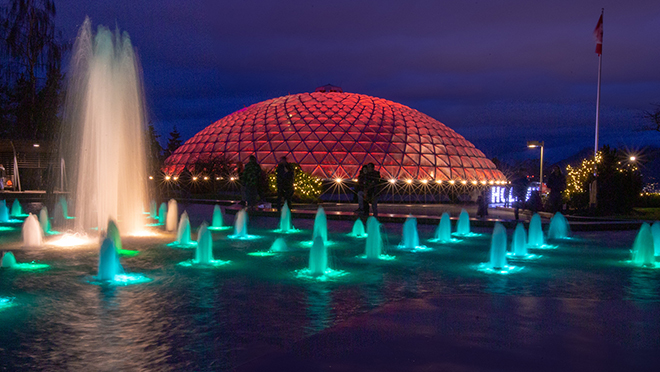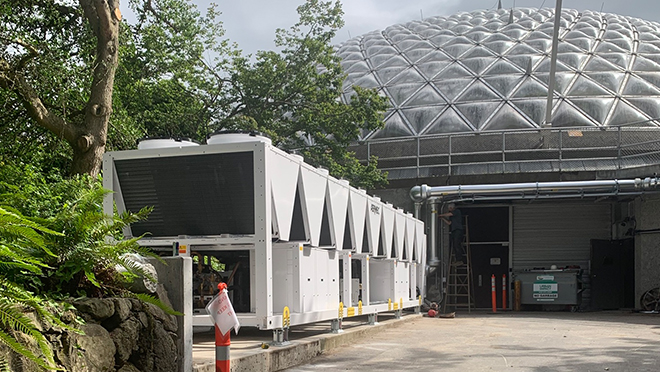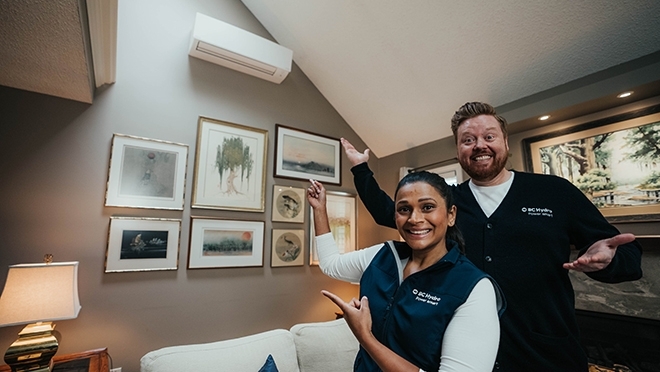Large heat pump now heats and cools Bloedel Conservatory

City of Vancouver's switch from fossil fuels makes it a Clean Energy Champion
Part of a series on BC Hydro Clean Energy Champions: businesses, homes, and institutions – large and small – recognized for reducing their reliance on fossil fuels.
'Really beautiful tropical plants and stunning birds – an absolutely lovely place to spend an hour or two. Our favourite was Art, the blue and gold macaw.'
– TripAdvisor visitor review of a visit to Vancouver's Bloedel Conservatory
Filled with exotic plants, flowers, and birds, the Bloedel Conservatory is a place that's easy to love. The indoor paradise was built in 1969 to celebrate biodiversity, and recently made upgrades to use clean electricity to become friendlier to the world outside the dome.
Earlier this year the City of Vancouver installed a large air source heat pump – more than 50 times the size of heat pump used in a typical B.C. home – that uses clean BC Hydro electricity instead of natural gas to heat and cool the dome's interior. In keeping with the City of Vancouver's Climate Emergency Action Plan, the switch from fossil fuel heating to powered-by-water electricity has cut greenhouse gas (GHG) emissions in the city-owned building by about 90%.
That's an annual GHG savings equivalent to taking 56 gas-powered cars off the road. And the heat pump will dramatically decrease the conservatory's energy bills.
"We just started up the heat pump this summer, so we don't have a year's worth of data yet," says Craig Edwards, who works in the city's real estate and facilities management department as its manager of energy and utilities. "But a feasibility study predicted the heating and cooling costs would drop by about 40% per year.”
The efficiency upgrades don't end there. All lighting in the building has been upgraded to energy-efficient LEDs. Gone are the 55 high-wattage metal-halide lights around the perimeter of the dome, and in their place are colour-changing LEDs that light up the dome – perched at Vancouver's highest point – at night.
The upgrades at Bloedel Conservatory are designed to help the City of Vancouver reach its 2030 goal of reducing carbon emissions from its buildings by half from 2007 levels.
"We're presently at about 35% emission reduction compared to 2007," says Edwards. "And although we have about 600 city-owned buildings, the Bloedel Conservatory project represents a reduction of about 2% of our overall greenhouse gas emissions. And that's huge. We keep chipping away with each of these larger building retrofit projects, getting a couple of percentage reductions with each of them."
In using clean electricity to fight climate change, the City of Vancouver has been recognized by BC Hydro as a Clean Energy Champion.

'It's a big glass dome, with a lot of heat loss'
As a home to more than 500 exotic plants and flowers, and 100 exotic birds that delight visitors, the Bloedel Conservatory thrives on the availability of natural light and a temperature-controlled environment. But minus walls and insulation to keep heat in and the sun's heat out, maintaining a temperature of around 22°C in the dome is a challenge.
Back in 2014, what was then a leaky, more than 40-year-old roof compromised of 1,488 acrylic bubbles in 32 different sizes, was replaced. This tricky job involved erecting protective scaffolding over the dome to protect the plants and birds inside and allow the conservatory to remain open to visitors while new panels were installed.
The new roof used thermal breaks between the glazing and aluminum frame to improve the thermal performance of the dome. But estimates were that the envelope improvement would only save the city about 2% on their natural gas bills.
"It's a big glass dome, with a lot of heat loss," says Edwards. "And the cooling loads are actually larger than the heating loads. When the sun shines in the summer it creates a huge need for cooling."
The large heat pump, located outside the building, replaced the need for using the natural gas boiler to heat the dome. The heat pump, which extracts warmth from the outside air even on the coldest winter days, also acts as an air conditioner to provide cooling. That eliminated the need for the building's chiller and cooling tower, which were at the end of their lives. Not only are there 90% emissions savings and considerable energy savings, the elimination of the cooling tower drastically cut the facility's water consumption and the risk of the spread of Legionella bacteria associated with cooling towers.
The heat pump system was also designed with the future effects of climate change in mind.
"The predictions are that cooling loads are going to go up significantly," says Edwards. "The current building code requires design for a minimum 28-degree summer peak temperature in Vancouver, but the prediction is that will be 32 degrees by 2050. And that will result in about a 30% higher cooling load for this building. So we designed the heat pump system to allow for installation of thermal storage banks, to increase capacity in the future as the climate warms."

Heat pumps key to city's carbon emission reductions
Over three quarters of carbon emissions from operating a building can be eliminated by switching from natural gas to electricity for space and water heating.
"We have really strong climate targets with our city-owned buildings, which I'm responsible for," says Edwards. "So we're reducing the greenhouse gas emissions in our city-owned buildings, and we're committed to showing leadership there. We're building all our new buildings to a zero-emission standard, as well as retrofitting all of our existing buildings."
Heat pumps are nothing new for the City of Vancouver, but the 210-tonne unit at the Bloedel Conservatory is the largest the city has installed to date. Edwards says the city recently installed a large heat pump at a police building downtown, and is studying the potential of retrofitting heat systems with heat pumps at a number of community centres. "We're retrofitting many large buildings with heat pumps, because we've had really good experience with reducing greenhouse gas emissions with them," he says.
With new buildings, the City of Vancouver is also aiming for a 40% reduction in construction-related embodied carbon emissions by 2030, over 2018 levels. They're doing this by using building materials that have lower embodied carbon emissions from extraction, manufacturing, assembling, replacement and disposal, such as wood, or lower embodied carbon concrete, metals, and insulation.
CleanBC offers funding to upgrade homes and commercial buildings
BC Hydro administers rebate and funding programs for the Government of BC's CleanBC programs that are helping make it easier for both residential customers and the operators of commercial buildings to convert to heat pump technologies.
Combined with federal incentives, B.C. residents switching from natural gas, propane, or oil heating to heat pumps can get up to $11,000 in rebates. And homeowners who want to upgrade from baseboard electric heating to heat pumps that provide both heating and cooling can be eligible for combined rebates of up to $7,000.
BC Hydro also runs the CleanBC Custom Program, which provides commercial customers energy study funding of up to $20,000 and capital cost funding – including funding for fuel switching to heat pumps – of up to $200,000 per customer.
Related:
